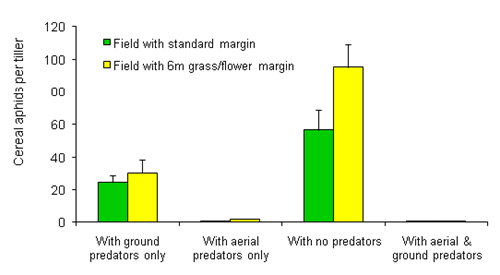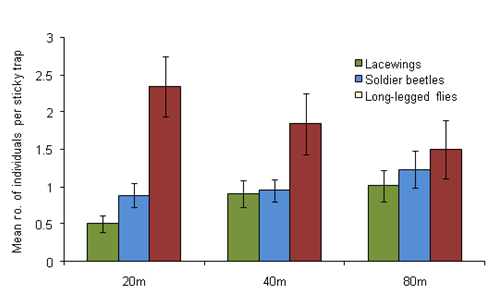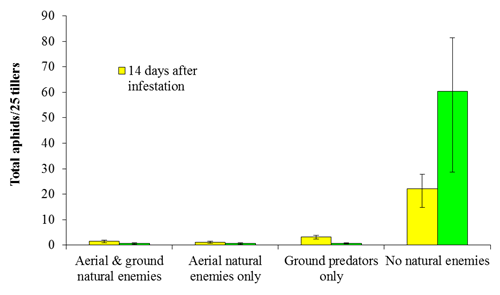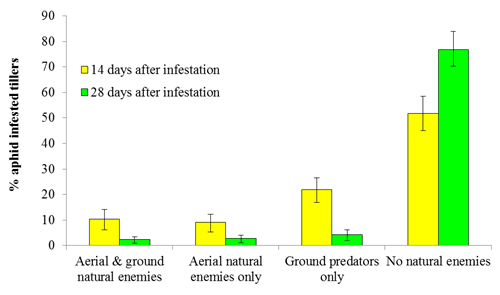 The control of crop pests in UK arable crops relies mostly on chemical pesticides yet there are alternative approaches that can supplement or replace these, collectively known as Integrated Pest Management.
The control of crop pests in UK arable crops relies mostly on chemical pesticides yet there are alternative approaches that can supplement or replace these, collectively known as Integrated Pest Management.
Few IPM techniques are used in arable crops, partly because we know little about the effectiveness of the pest’s natural enemies or how to encourage them across farms.
With our partners from Rothamsted Research and Imperial College, London, we are evaluating the relationships between pests and their predators and parasitoids (parastic wasps), and how these are affected by natural habitats such as hedgerows and field margins.
We have found that predators that fly (e.g. hoverflies, parasitic wasps and long-legged flies) are more effective at reducing the number of cereal aphids than ground-active ones (e.g. beetles and spiders). We also found that the presence of six-metre-wide flower-rich field margins made little difference to the abundance of these predators in an area where there was plenty of natural habitat (see Figure 1).
Figure 1: Aphid abundance in the presence of different guilds of predators

However, we did find that fields surrounded by six-metre grass margins contained a significantly greater number of money spiders, soldier beetles and aphid-eating rove beetles than fields without a margin (see Figure 2), and the total number of aphid predators flying over the field was significantly greater earlier in the season (beginning of May) where a margin was present. However, these predators may disperse further than a single field early in the season.
Figure 2: Invertebrate numbers in fields with and without 6m grass/flower margins

 By positioning traps at different distances from the field margin (20m, 40m and 80m) we were able to determine how far from the field margin they could fly.
By positioning traps at different distances from the field margin (20m, 40m and 80m) we were able to determine how far from the field margin they could fly.
Long-legged flies were unable to fly very far from the field margin, whereas lacewings and soldier beetles showed the opposite trend, as they may have been searching for aphid prey or, in the case of lacewings, aphid patches within which to lay their eggs (see Figure 3).
Figure 3: The effect of distance from margin on numbers of predatory insects caught on sticky traps

In 2006 and 2007 we tested the effectiveness of cereal aphid control. We selected farms (12 or 14) with varying proportions of grass margins across Hampshire and Dorset. In one wheat field per farm, we set up exclusion cages 80 metres from the nearest field boundary. The cages either excluded ground-active, flying or both types of predators or allowed all predators access to artificially created cereal aphid colonies. By counting aphids at two-week intervals we were able to quantify the level of aphid control for the different groups of predators.
We examined the relationship between of land use within 100, 250, 500 or 750-metre radius of the exclusion cages and the level of aphid control provided by the predators. Flying predators alone provided almost total aphid control, whereas ground predators although consuming most aphids (see Figure 4) the number of infested wheat tillers remained higher (see Figure 5).
Figure 4: Aphid abundance in the presence of different guilds of predators

Figure 5: Proportion of aphid infested wheat tillers in the presence of different guilds of predators

Aphid control provided by the flying predators increased as the area of grass margins increased and this relationship held true when margins were within 250, 500 and 750 metres. To investigate the effect of flower-rich areas, we sprayed sown flower strips with a Rubidium trace element that could be detected in insects and then mapped the distribution in relation to aphids in two adjacent fields. We did this with sticky traps placed in a grid pattern across the fields. Hoverflies that are known to consume nectar were abundant, but only 1.5% of those tested had fed in the flower-rich strip and there was little evidence that they were located near aphids. In contrast, another group of predatory flies (Empididae) showed a strong correlation with cereal aphid numbers. Overall, the study suggested that agri-environment schemes can benefit biological control.
Further reading
- Holland, J.M., Oaten, H., Southway, S. & Moreby S. (2008). The effectiveness of field margin enhancement for cereal aphid control by different natural enemy guilds. Biological Control 47, 71–76.
- Holland J.M., Oaten H., Birkett T.C., Simper J., Southway S. & Smith B.M. (2012). Agri-environment scheme enhancing ecosystem services: A demonstration of improved biological control in cereal crops. Agriculture, Ecosystems and Environment 155, 147-152.